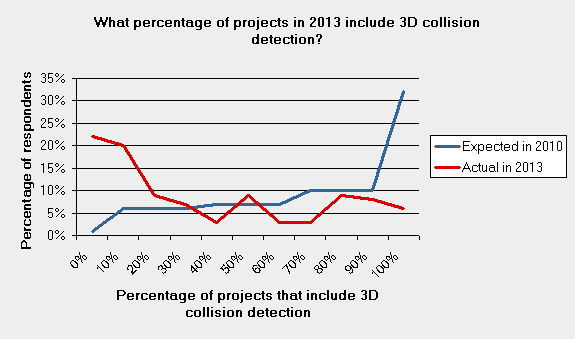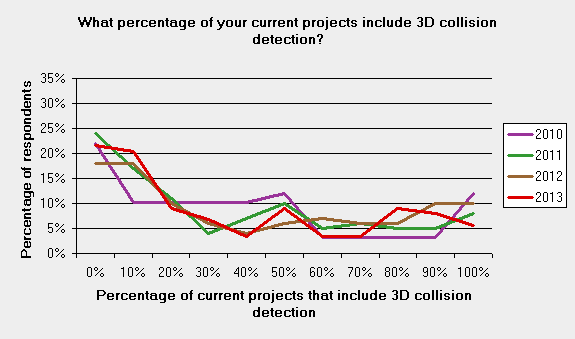For the fourth year in a row, we surveyed people in the MEP industry about their use of BIM. Next month we will release the full results from our survey. For now, we want to focus on one finding in particular, because we think it is the most important result.
In our original survey in 2010, we asked respondents to make a prediction: “Three years from now, what percentage of your projects will include 3D collision detection?” This year, we asked respondents a related question: “Today, what percentage of your projects include 3D collision detection?” We can now finally evaluate the accuracy of the predictions.
The result: far fewer projects today include 3D collision detection than people predicted 3 years ago.
The graph below compares the answers to the two questions. The answer to the question is on the x-axis. The percentage of respondents who gave each answer is on the y-axis.
For example, on the left side of the graph is the percentage of respondents who answered the survey question with 0%. In 2010, about 1% of respondents expected none of their projects to include 3D collision detection. In 2013, over 20% of respondents said that none of their current projects include 3D collision detection.
On the right side of the graph is the percentage of respondents who answered the survey questions with 100%. In 2010, over 30% of the respondents expected all of their projects to include 3D collision detection. In 2013, a little more than 5% of respondents said that all of their current projects include 3D collision detection.

As you can tell from the graph, the percentage of projects this year that include 3D collision detection is far less than the percentage predicted three years ago.
In addition to expectations, we have also tracked the use of 3D collision detection over the last three years. Even if use of 3D collision detection did not match expectations from 2010, has use changed at all since then? The next graph displays the use of 3D collision detection for the different years of our survey.

All four lines have a very similar shape. The use of 3D collision detection has not changed in the last three years.
The above results raise two interesting questions:
Question 1: Why is there such a disconnect between expectations and reality? All the discussion in the industry is about how BIM is the future for all projects. But that has been the discussion for at least three years. In that time, nothing has changed significantly. What is happening that causes everyone to expect BIM usage to increase in the future? Why has the change in BIM usage not met expectations?
Question 2: What is going to be different over the next three years as compared to the last three years? Contrary to everyone’s expectations, BIM has not recently taken off. If BIM is to become more common in the future, something is going to need to change. Will software improve more over the next three years than it did over the last three? Will building owners be more willing to spend extra money on design to include BIM? Will BIM become cheaper than alternatives?
Our best guess is that the disconnect is caused by the general disconnect between architects and engineers. The two professional groups see the world differently. For architects, BIM has obvious and immediate benefits. They assume engineers will gain the same benefits. The reality is that the easy benefits that architects receive–such as 3D modeling–are nearly useless for engineers. Architects are pressuring engineers to use BIM, which causes engineers to expect to be using it in the future. But architects are also pressuring engineers to produce designs faster and cheaper. When a choice between faster and cheaper versus BIM has to be made, BIM loses.
We do not see any signs to indicate that the industry will change such that BIM will suddenly become more popular than it is now. BIM will continue to be used on some projects that can afford large design fees. BIM will continue to be used on complex projects where the benefits are large enough to exceed the costs. For the vast majority of projects, BIM will continue to be a luxury that building owners are not willing to pay for.
What do you think? Are we asking the right questions? And do we have the right answers? Let us know in the comments.
There is one objection to our survey that we want to address directly. The objection is that 3D collision detection is not the same thing as BIM. The 3D Collision Detection Versus BIM article explains why we agree with the objection, but still consider the two concepts interchangeable.
